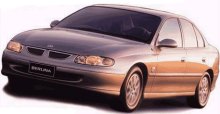 As
a subsidiary of GM, Australian car maker Holden used to base its best
seller
Commodore on the Opel Omega / Senator family. However, the latest
Commodore
VT is claimed to be a completely independent car which was designed
entirely,
excluding powertrain, by Holden itself starting from drawing board. As
a subsidiary of GM, Australian car maker Holden used to base its best
seller
Commodore on the Opel Omega / Senator family. However, the latest
Commodore
VT is claimed to be a completely independent car which was designed
entirely,
excluding powertrain, by Holden itself starting from drawing board.
Externally
looking, Commodore
VT is exactly the same as Omega, except minor differences in detail. In
fact, it is considerably bigger in all dimensions. Here is the
dimension
comparison between Commodore and Omega:
Especially notice that Commodore's wheelbase is 56 mm longer, thus enable more interior space for which Australian ask. (They are always proud that the Commodore can have three 6ft4-height passengers sitting comfortably at the rear) While the chassis is new, the suspensions are modified from the previous generation Commodore VS, which was based on the previous Omega. In other words, MacPherson struts up front and semi-trailing arms located at the rear. The setting is relatively hard to cope with the ultra-rough Australian country roads. For engines, Holden did no favour on the refined German Ecotec V6. Instead, they adopted GM’s pushrod engines for lower cost, ease of service and production reasons. (V6s are produced locally) Base model is powered by the Series II V6 displacing 3.8 litres. With 197 hp and 224 lbft, it is high on torque but not really smooth and quiet by world standards. Next up is the supercharged version outputting 230 hp and 277 lbft, but its existence is threatened by the top of the range LS1 V8, coming from Chevrolet Corvette / Camaro / Firebird, with lower state of tune it still pumps out a massive 295 hp and 330 lbft. Just mind the fuel consumption. While the V6s feels inferior to foreign competitor’s multi-valve V6s, the V8 offers sports car performance at a low price, that makes the Commodore so special. Here, we are talking about 0-60 mph in six seconds or so even in the automatic form. Of course, high performance should be matched with a good chassis, otherwise it would have been just another Chevrolet Impala SS. Obviously, Commodore does much better, especially is the SS model. The chassis is strong, the steering are sharp and accurate, suspension setting bias towards a bit handling than ride, massive 235/45 VR17 tyres provides a lot of grip ... what’s more, the rear-wheel-drive chassis is happy to play power slide game ! Less satisfactory is the transmissions. Two of the three gearboxes come from GM, including the popular 4-speed auto and six-speed manual for V8. The former works well but with neither adaptive electronics nor sequential manual mode, so no fun at all. The 6-speeder has the last two ratios too tall, thus works like over-drive. The remaining is a 5-speed manual from Getrag. Probably the best of all, what a pity its service is limited to the least powerful V6.
The bottom line
is : being
the best-selling family sedan in Australia, Commodore has done very
well
to suit Australia's needs as well as to give European and Japanese car
makers a lesson. The best family sedan it may not be, but it reminds us
what is driving fun. Sometimes sacrificing refinement for driving fun
is
worthy, especially when the rest of the world is overcrowded with
refined
cars. I just hope the globalisation of car industry will never spread
to
Australia. |
|||||||||||||||
| The above report was last updated on 28 Feb 2000. All Rights Reserved. |
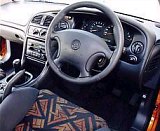 Compare
with European and Japanese cars, Commodore is not renowned for
refinement.
The suspensions do not iron out bumps as well, the pushrod engines feel
harsher, the cabin trimming looks as cheap as the car actually is, poor
fit and finish of plastic parts in cabin, and poor grade of plastic
too.
Space and comfort, however, are superb. Benefited by the extra size, it
has plenty of room front and rear. Seats are big, soft yet supportive.
The size of boot is no less impressive.
Compare
with European and Japanese cars, Commodore is not renowned for
refinement.
The suspensions do not iron out bumps as well, the pushrod engines feel
harsher, the cabin trimming looks as cheap as the car actually is, poor
fit and finish of plastic parts in cabin, and poor grade of plastic
too.
Space and comfort, however, are superb. Benefited by the extra size, it
has plenty of room front and rear. Seats are big, soft yet supportive.
The size of boot is no less impressive. 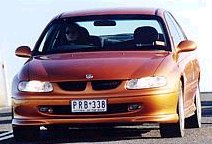 Holden
Special Vehicle department (HSV) is a joint venture between UK's TWR
and
Holden and is renowned for modifying Commodores into giant killer
sports
sedans. Like many car tuners, HSV is good at modifications using
aftermarket
components and has to earn its own development budget. That contrast to
BMW’s M division, which is given a big budget to develop whatever they
desired, such as the sophisticated engines for M3 and M5. As a result,
HSV’s cars usually seem less well finished as a complete product.
Holden
Special Vehicle department (HSV) is a joint venture between UK's TWR
and
Holden and is renowned for modifying Commodores into giant killer
sports
sedans. Like many car tuners, HSV is good at modifications using
aftermarket
components and has to earn its own development budget. That contrast to
BMW’s M division, which is given a big budget to develop whatever they
desired, such as the sophisticated engines for M3 and M5. As a result,
HSV’s cars usually seem less well finished as a complete product.
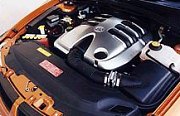 As
experienced in Corvette C5, the power delivery of this LS1 engine is
very
linear, still with massive of bottom end torque but no longer as lazy
to
rev as older generations small block V8s. That’s not to say it could
rev
freely to 6,000 rpm - after the 5,600 rpm peak, power runs out quickly.
This is still a push-rod engine. For the same reason, it’s not deemed
to
be a smooth V8 compare with competitors - provided you regard M5, E55
AMG,
XJR and S6 as competitors of course. The huge exhaust generate brutal
and
low frequency noise that might excite someone, but some prefer the pure
mechanical noise of dohc engines.
As
experienced in Corvette C5, the power delivery of this LS1 engine is
very
linear, still with massive of bottom end torque but no longer as lazy
to
rev as older generations small block V8s. That’s not to say it could
rev
freely to 6,000 rpm - after the 5,600 rpm peak, power runs out quickly.
This is still a push-rod engine. For the same reason, it’s not deemed
to
be a smooth V8 compare with competitors - provided you regard M5, E55
AMG,
XJR and S6 as competitors of course. The huge exhaust generate brutal
and
low frequency noise that might excite someone, but some prefer the pure
mechanical noise of dohc engines. 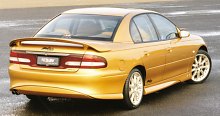 Suspension
design is not the most sophisticated - front MacPherson strut and rear
semi-trailing arm as in the normal Commodore. (HSV is developing a new
multi-link rear for the next generation GTS) However, stiff setting and
good choice of dampers result in rock-steady body control. Roll is just
minimum, a thing also thanks to the low profile tyres. Predictably,
ride
quality is not so good. It is harder than all the aforementioned
rivals,
although not to the extent that feels discomfort. Steering is quick and
accurate. It requires just 2.5 turns to go from lock to lock. 18-in
235/40ZR18
tyres provides a lot of grip to match with the good body control.
Suspension
design is not the most sophisticated - front MacPherson strut and rear
semi-trailing arm as in the normal Commodore. (HSV is developing a new
multi-link rear for the next generation GTS) However, stiff setting and
good choice of dampers result in rock-steady body control. Roll is just
minimum, a thing also thanks to the low profile tyres. Predictably,
ride
quality is not so good. It is harder than all the aforementioned
rivals,
although not to the extent that feels discomfort. Steering is quick and
accurate. It requires just 2.5 turns to go from lock to lock. 18-in
235/40ZR18
tyres provides a lot of grip to match with the good body control.
 11
years ago, Lotus Omega set a performance record yet to be matched by
any
sports saloons - it was timed in 5.1 seconds to complete 0-60. Even
without
top speed tested, people believed it could top somewhere near 180 mph,
in contrast to the electronically limited 155 mph of today’s sports
saloons.
Now HSV is saying its new rocket, Commodore GTS 300, has broken the
record
by doing 0-60 in a mere 4.8 seconds (or 5.1 sec for 0-100 km/h). Is it
true? not really. The best timing recorded by magazines is 5.2 sec. In
terms of maximum speed, Australian sources estimated between 165 and
170
mph.
11
years ago, Lotus Omega set a performance record yet to be matched by
any
sports saloons - it was timed in 5.1 seconds to complete 0-60. Even
without
top speed tested, people believed it could top somewhere near 180 mph,
in contrast to the electronically limited 155 mph of today’s sports
saloons.
Now HSV is saying its new rocket, Commodore GTS 300, has broken the
record
by doing 0-60 in a mere 4.8 seconds (or 5.1 sec for 0-100 km/h). Is it
true? not really. The best timing recorded by magazines is 5.2 sec. In
terms of maximum speed, Australian sources estimated between 165 and
170
mph.
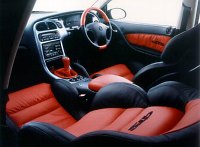 Entering
a corner, there’s a little bit initial understeer like any well-sorted
sports saloon. Keep pushing hard, the car can power slide progressively
and predictably, sometimes even 4-wheel drift is obtainable. At the
limit,
it is no inferior to the M5. Ride comfort is pretty good for this kind
of cars. However, M5 and Audi S6 are even better. There’s still quite a
lot of unsprung weight of the semi-trailing arms to cope with.
Entering
a corner, there’s a little bit initial understeer like any well-sorted
sports saloon. Keep pushing hard, the car can power slide progressively
and predictably, sometimes even 4-wheel drift is obtainable. At the
limit,
it is no inferior to the M5. Ride comfort is pretty good for this kind
of cars. However, M5 and Audi S6 are even better. There’s still quite a
lot of unsprung weight of the semi-trailing arms to cope with.
 The
updated Commodore, VY, introduced the following improvement in late
2002:
The
updated Commodore, VY, introduced the following improvement in late
2002: